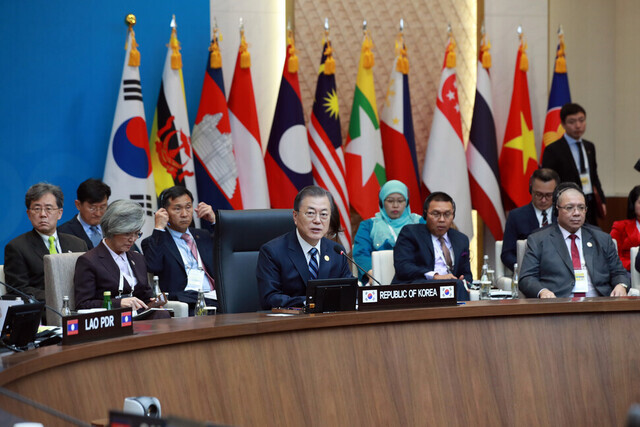hankyoreh
Links to other country sites 다른 나라 사이트 링크
Southeast Asia replaces China as “world’s factory”

Global direct foreign investment in the ten countries of the Association of Southeast Asian Nations (ASEAN) amounted to US$731 billion in 2016-2020. That was more than the direct investment in China (US$698.9 billion) over the same period.
Investment in ASEAN rose by 30.4% from the 2011-2015 period, while investment in China rose by 10.4%, showing that investment in ASEAN is growing at over double the rate in China.
These statistics, released by the UN Conference on Trade and Development, lead the Federation of Korean Industries (FKI) to believe that we’re witnessing an “ASEAN shift,” in which the axis of the global supply chain moves to ASEAN. The FKI has concluded that ASEAN is taking the mantle from China for the “workshop of the world.”
ASEAN, whose member states include Thailand, Malaysia, Indonesia, Singapore, and the Philippines, celebrated its 54th anniversary on Aug. 8.
“The shift of the global supply chain to ASEAN is accelerating for a number of factors, including foreign investors pulling out of China to avoid export controls that the US imposed on China in 2018 as part of their trade war and the shutdown of manufacturing centers in China when COVID-19 began to spread,” the FKI said.
Because of this supply chain realignment, ASEAN’s share of the world’s direct foreign investment surpassed China’s in 2017 (ASEAN 9.4%, China 8.3%). By 2019, that gap had widened to 2.6 percentage points (ASEAN 11.8%, China 9.2%).
The FKI noted that, last year, this trend was reversed (ASEAN 13.6%, China 15.0%) as new investment projects in ASEAN were delayed because of the pandemic.
When investment in ASEAN is broken down by country, South Korea’s rate of increase is particularly noticeable. Korea’s direct investment in the region in 2016-2020 amounted to US$31.7 billion, up 74.2% from 2011-2015 (US$18.2 billion). That was the highest rate of increase among major countries; the next highest were China (65.4%), Taiwan (40.6%), and Japan (21.8%).
“Since 2016, direct investment in ASEAN from Asian countries including South Korea, China, Japan, and Taiwan has seen double-digit growth. ASEAN is now nearly on a level with China in intermediate goods trade in Asia,” the FKI said.
China accounted for 31.2% of intermediate goods trade in Asia in 2019, while six ASEAN countries (Indonesia, the Philippines, Vietnam, Thailand, Singapore, and Malaysia) made up 30.8%.
According to figures from the Export-Import Bank of Korea, ASEAN accounted for a larger share of South Korea’s total foreign direct investment than China for the first time in 2014 (ASEAN 16.2%, China 12.9%). That gap grew even wider in 2019 (17.3%, 10.3%) and 2020 (20.3%, 9.2%).
By Kim Young-bae, senior staff writer
Please direct comments or questions to [english@hani.co.kr]

Editorial・opinion
![[Editorial] Penalties for airing allegations against Korea’s first lady endanger free press [Editorial] Penalties for airing allegations against Korea’s first lady endanger free press](https://flexible.img.hani.co.kr/flexible/normal/500/300/imgdb/original/2024/0502/1817146398095106.jpg) [Editorial] Penalties for airing allegations against Korea’s first lady endanger free press
[Editorial] Penalties for airing allegations against Korea’s first lady endanger free press![[Editorial] Yoon must halt procurement of SM-3 interceptor missiles [Editorial] Yoon must halt procurement of SM-3 interceptor missiles](https://flexible.img.hani.co.kr/flexible/normal/500/300/imgdb/child/2024/0501/17145495551605_1717145495195344.jpg) [Editorial] Yoon must halt procurement of SM-3 interceptor missiles
[Editorial] Yoon must halt procurement of SM-3 interceptor missiles- [Guest essay] Maybe Korea’s rapid population decline is an opportunity, not a crisis
- [Column] Can Yoon steer diplomacy with Russia, China back on track?
- [Column] Season 2 of special prosecutor probe may be coming to Korea soon
- [Column] Park Geun-hye déjà vu in Yoon Suk-yeol
- [Editorial] New weight of N. Korea’s nuclear threats makes dialogue all the more urgent
- [Guest essay] The real reason Korea’s new right wants to dub Rhee a founding father
- [Column] ‘Choson’: Is it time we start referring to N. Korea in its own terms?
- [Editorial] Japan’s rewriting of history with Korea has gone too far
Most viewed articles
- 160% of young Koreans see no need to have kids after marriage
- 2Months and months of overdue wages are pushing migrant workers in Korea into debt
- 3Presidential office warns of veto in response to opposition passing special counsel probe act
- 4Hybe-Ador dispute shines light on pervasive issues behind K-pop’s tidy facade
- 5[Editorial] Penalties for airing allegations against Korea’s first lady endanger free press
- 6Historic court ruling recognizes Korean state culpability for massacre in Vietnam
- 7Japan says it’s not pressuring Naver to sell Line, but Korean insiders say otherwise
- 8Story of massacre victim’s court victory could open minds of Vietnamese to Korea, says documentarian
- 9Historic verdict on Korean culpability for Vietnam War massacres now available in English, Vietnames
- 10[Guest essay] How Korea must answer for its crimes in Vietnam